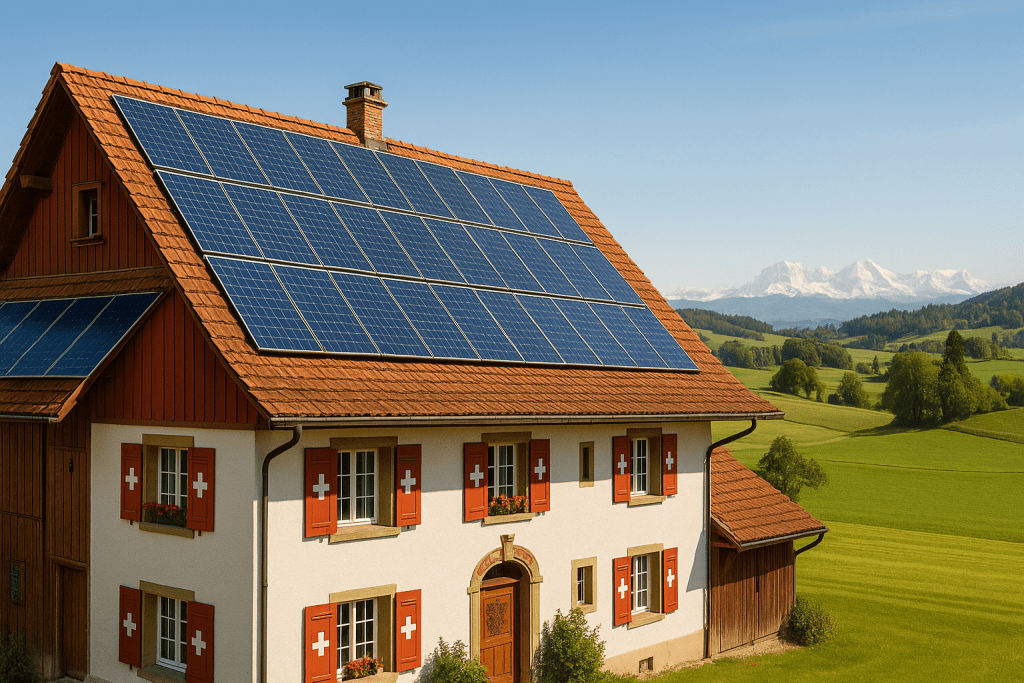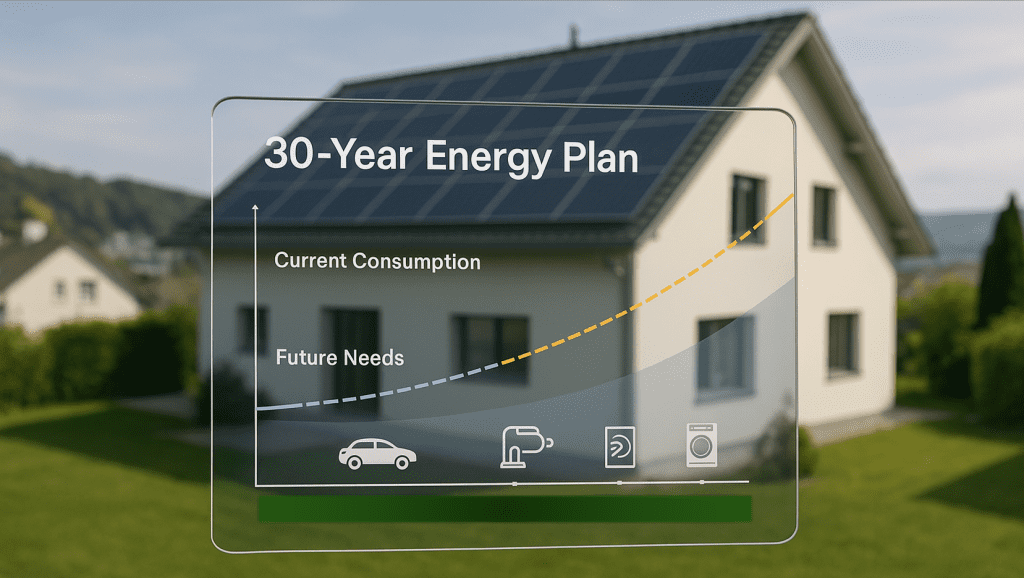Turn Your Aargau Roof into a Solar Income Stream In Aargau

Harnessing solar power in Canton Aargau is no longer a niche environmental statement—it’s a mainstream financial strategy. With robust solar irradiation, significant government subsidies, and favorable economics, homeowners can transform their roofs into assets that generate clean energy and a steady income.
Another strong reason to tap into your roof’s solar potential is the above-average rise in electricity prices in Aargau, with some municipalities now ranking among the ten most expensive in Switzerland.
This guide provides a comprehensive overview of how to turn your Aargau roof into a solar goldmine.
Want to skip the guide and go straight to checking your roof’s earning potential?
Get a Free Solar Proposal for Your RoofAargau’s Solar Potential: More Sun Than You Think
Imagine a crisp spring morning along the Reuss River in Bremgarten. The light that illuminates the historic town and makes the water sparkle is more than just scenic; it represents a powerful and underutilized resource. According to MeteoSwiss, Canton Aargau is in a region that receives an impressive average of 1,100 to 1,300 kilowatt-hours (kWh) of solar irradiation per square meter (m²) annually.
To put it into perspective, this energy is enough to power an electric vehicle for over 6,000 kilometers or run a modern refrigerator (A+++) for 8 to 10 years.
Aargau’s Solar Edge:
- High Irradiation: Aargau’s solar potential is on par with, and in some cases better than, regions in Southern Germany, a leader in European solar energy production.
- Cooler Temperatures: Unlike hotter climates, solar panels in Aargau operate at cooler average temperatures, which increases their efficiency and energy output.
- Stable Climate: Situated on the Swiss Plateau, the canton benefits from consistent sunshine throughout the spring and summer, making energy production reliable and predictable.
The myth that Switzerland lacks sufficient sun for viable solar power is demonstrably false. Aargau’s steady irradiation and favorable climate create a perfect environment for highly efficient, year-round energy production.
PV Installation Practices: Roof, Ground & Permits
Proper installation is key to maximizing the output and longevity of your solar array. This involves optimizing the placement of panels and navigating the local permitting process.
Optimal Placement and Orientation
- Roof-Mounted Systems: The ideal orientation for solar panels is due south with a tilt angle of 30–35 degrees to capture maximum sunlight. However, east-west facing roofs are also highly effective, as they can generate a consistent output throughout the day, aligning well with household consumption patterns.
- Ground-Mounted Systems: For properties with sufficient land, ground-mounted systems offer flexibility in orientation and tilt, but as standalone structures, they require a formal building permit, unlike most rooftop installations.
- Façade Installations: Integrating solar panels into the building’s façade is an innovative solution, particularly for commercial buildings, and is increasingly supported by advanced, aesthetically pleasing panel technologies. Thanks to their vertical orientation, façade installations are particularly effective for generating energy during the winter months, when the sun is lower in the sky.
The Aargau Permitting Process
In Canton Aargau, installing solar panels on existing buildings is often straightforward. Most rooftop systems that are well-integrated into the roof’s appearance do not require a formal building permit. Instead, they fall under a simplified notification procedure known as the “Meldeverfahren.”
You must register the planned installation with the local building authority. If there are no objections within 30 days, you can proceed with the installation. However, installations in protected heritage zones (like old town centers), on listed buildings, or on façades require a full building permit (“Baugesuch”).
System Sizing & Economics: kWp That Fit Your Roof
Until recently, the primary economic driver when planning the size of a new solar plant was maximizing self-consumption—using the solar power you generate to avoid purchasing expensive electricity from the grid. This approach often led to roofs being only partially covered with solar panels—falling short of their full potential.
What are the advantages of fully covering your roof with solar panels in Aargau?
There are three important reasons:
- Plan for long-term energy needs.
Modern solar panels typically operate for 30 to 40 years. So it’s essential to think beyond your current consumption. As more appliances, heating systems, and vehicles become electric, your electricity demand will rise. If you size your solar system based only on your latest energy bill, you may soon fall short of what your household or building actually needs.

- Expanding later can be costly and inefficient.
Adding panels later isn’t as simple as plugging in more modules. You may need to hire a contractor and an electrician to redesign the system, upgrade your inverter, and reinstall scaffolding. You’ll also face additional administrative work, including new permits. Most importantly, you’ll lose the cost benefits of scaling your installation from the beginning—making the project more expensive in the long run.
- You can now sell surplus electricity—locally.
Thanks to new regulations (ZEV, vZEV, LEG), you’re no longer limited to selling excess power to your local utility at low rates. You can now sell it directly to neighbors or other consumers within your municipality. That means your solar plant isn’t just an energy solution—it can also become a reliable source of income.
If fully covering your roof with solar panels is beyond your budget, you can consider contracting options such as a Power Purchase Agreement (PPA) or renting your roof. This way, you avoid the upfront investment but still benefit financially from the solar plant’s operation.
Find out how you can profit from your rooftop solar without upfront investment costs.
Get a Free Solar Proposal for Your RoofSo what role does your electricity usage play in how your solar system should be designed?
The most valuable solar electricity is the one you use directly in the building where it’s generated. That’s why it’s important to analyze your or your tenants’ annual electricity consumption—either by reviewing your bills over a 12-month period or requesting data from your utility provider. You should also look for ways to shift energy-intensive activities to daylight hours, when solar production is highest. However, in most cases, self-consumption from a solar plant without storage is limited to around 30%. To increase this to 80–90%, you’ll need to invest in a battery system that stores excess solar power for use during non-sunny periods.
Technology to Boost Returns
- Power Optimizers and Micro-inverters: These devices manage the output of each panel individually, mitigating power loss from shading caused by chimneys, trees, or adjacent buildings.
- Battery Storage: A home battery stores excess solar energy produced during the day for use in the evening, dramatically increasing your self-consumption rate from a typical 30% to as high as 70%.
Cost Breakdown & Real-World Payback in Canton Aargau
Investing in a solar PV system has become increasingly affordable. A combination of falling hardware costs and substantial subsidies makes the financial case more compelling than ever.
Below is a sample cost breakdown for a typical 10 kWp system in Aargau, before and after incentives. A system of this size generally costs between CHF 25,000 and CHF 32,000.
| Item | Cost (CHF) |
|---|---|
| Gross System Price (Hardware & Installation) | 30,000 |
| Less Federal “Einmalvergütung” (EIV) Subsidy | -3,600 |
| Less Cantonal Aargau Subsidy (If done together with isolations or energy efficiency improvements!. For normal 750 CHF, for indach 1500 CHF for 25m2 ) | -750 |
| Less Municipal Subsidy (Example: City of Aarau) | -1,500 |
| Net Investment Outlay | 24,150 |
| Additional Tax Deduction Savings (Approx.20%) | -4,830 |
| Final Effective Cost | 19,320 |
Note: Costs are illustrative and can vary based on installer, components, and roof complexity. Subsidies are subject to change. The municipal subsidy shown is an example from the City of Aarau’s program and is not available canton-wide.
Annual Savings and Payback
- Annual Production (10 kWp system): ~10,000 kWh
- Value of Self-Consumed Power (60% only with battery!): 6,000 kWh * 29.9 Rp./kWh = ~CHF 1,794 saved.
- Value of Exported Power (40%): 4,000 kWh * 11.15 Rp./kWh = ~CHF 446 earned.
- Total Annual Financial Benefit: ~CHF 2,240
- Simple Payback Period (Net Investment / Annual Benefit): ~ 8.6 years
With a system lifespan of over 25-30 years, a solar installation in Aargau represents a secure, high-return investment.
The Local Solar Market: Installers & Flagship Projects
The solar market in Canton Aargau is mature and competitive, with a wide range of highly qualified installers. When selecting an installer, look for certified professionals with a strong track record in the region. Swissolar, the well-known association in the Swiss solar industry, provides a directory of accredited partners, known as “Solarprofis”.
Leading energy providers in the canton, such as AEW Energie AG and many private companies are also active in promoting solar energy and offer their own installation services and contracting models. The canton itself is leading by example, with large-scale PV systems on public buildings. A notable recent project is the installation on the roof of the Post’s logistics center in Villmergen, which is the size of a football field and powers the facility and surrounding region.
Subsidies & Incentives: Turning Sunshine Into Swiss Francs
Switzerland offers a multi-layered subsidy system to encourage the adoption of solar power. Homeowners in Aargau can benefit from both federal and, in some cases, cantonal and municipal programs.
- Federal One-Time Remuneration (Einmalvergütung – EIV): Administered by Pronovo, this program provides a one-time payment for new PV installations. For a standard 10 kWp system installed in 2025, the subsidy would be approximately CHF 3,600. The rates are reviewed regularly, and for 2025, the per-kWp payment was slightly reduced, but bonuses for parking lots, high-altitude or steeply-angled installations, and plants with no local consumption were increased. You can calculate your subsidy in the Pronovo calculator
- Cantonal Förderprogramm: The Aargau building program (Das Gebäudeprogramm) provides attractive bonuses when solar installations are carried out in conjunction with roof insulation, reflecting their goal of improving overall building envelope efficiency. For instance, homeowners can receive an additional CHF 40–60 per square meter of insulated roof or façade when they include a photovoltaic system as part of their renovation package. This subsidy is only available if applied for together, and before the work commences.
- Municipal Förderprogramm: Some municipalities, like the City of Aarau, offer their own significant grants that can substantially reduce the initial investment. It is vital to check for local programs.
- Tax Deductions: The entire net cost of your solar installation can be deducted from your taxable income in Canton Aargau, providing an additional and significant financial benefit.
Most cantons provide free consultation on energy efficiency and environment-friendly topics, including solar systems and benefits, as well as investment options.
Tariffs, Feed-in & Net-Metering Rules
Understanding local electricity tariffs is essential for calculating the profitability of a PV system.
- Electricity Tariffs: In 2025, the average cost of purchasing electricity from the grid for a typical household in the AEW Energie AG service area is approximately 29.9 Rappen (Rp.) per kWh. This marks a 14% decrease from the previous year. Every kilowatt-hour of solar energy you consume at home saves you this amount.
- Feed-in Tariffs (Rückliefervergütung): When your system produces more electricity than you can use, the surplus is exported to the grid. For 2025, AEW will pay 8.15 Rp./kWh for this energy during peak hours, plus an additional 3 Rp./kWh for the guarantee of origin (HKN), for a total of around 11.15 Rp./kWh.
The significant difference between the purchase and the feed-in tariffs underscores why maximizing self-consumption is the key to financial success.
Contracting Models: Own It, Lease It or Sign a PPA
Homeowners have several options for financing and managing a solar installation.
- Direct Ownership: This is the most common model. You purchase the system outright, entitling you to all the energy savings, feed-in tariff revenues, and government subsidies. It offers the highest long-term return on investment. For most family home owners, direct ownership provides the most significant financial advantages.
- Solar Lease: In a leasing model, a third-party company installs and owns the panels on your roof. You pay a fixed monthly fee to use the system. This lowers the upfront cost but also reduces your overall financial benefit, as the leasing company retains the subsidies and some of the savings. However, you typically have the rights to purchase the system at a later stage.
- Power Purchase Agreement (PPA): Similar to a lease, a developer installs and owns the system. You agree to purchase the solar power it generates at a predetermined price, which is typically lower than the utility rate. This model is more common for commercial installations or buildings with multiple owners where reaching an agreement to finance an own installation may be difficult (e.g.: MFH)
- Rent out your roof: A company installs and owns the panels on your roof, and sells to power to a third party. They pay you rent from the proceeds, and you do not use any of the locally produced power.
- Combine 3 and 4: Some companies offer this option in case of larger roofs. Sometimes you can also participate in the investment to an extent of your liking, thus benefiting from both the rent and the yield.
However, as part of the Gebäudeprogramm, you can receive cantonal support for roof or façade insulations—regardless of whether you own the solar system or someone else installs it on your property. So if your roof or walls need insulation, it’s the perfect time to consider adding a solar installation or leasing your roof to someone who will—the cantonal subsidy after the solar installation will be yours anyway.
Your 8-Step Roadmap to a Aargau PV System
If you’re considering a PPA or roof leasing solution to harness your building’s solar potential, Solergy can help you turn your roof into a source of steady income—with zero cost and effort on your part. If you decide that full ownership suits you better, going from initial interest to a fully operational solar power plant on your roof can be a smooth process if you follow a clear plan.
- Initial Consultation & Quote: Contact certified local installers for a site assessment and a detailed, no-obligation quote that includes a profitability forecast. They will also assess your roof and determine how many panels it can accommodate. Keep in mind that today’s solar panels can operate for 30 to 40 years. If your roof isn’t structurally sound enough to support the panels for that long, it’s wise to renovate it beforehand—doing so later would be significantly more costly, as it would require removing and reinstalling the panels. Some cantons, including Aargau, offer additional subsidies for solar installations when combined with roof insulation work.
- System Design & Contract: Choose an installer and finalize the system design, including panel layout, inverter selection, and any battery storage. Sign the contract.
- Permits and Subsidies: The installer will typically handle the “Meldeverfahren” notification to the municipality and assist you with filing applications for federal (Pronovo) and any available local subsidies.
- Hardware Ordering & Delivery: Once permits are clear, the installer orders the panels, inverter, and mounting hardware.
- Installation: The mounting system is installed, followed by the solar panels and the electrical wiring connecting the system to your home’s main panel.
- Grid Connection & Inspection: The local utility inspects the installation to ensure it meets all safety and technical standards before approving the connection to the grid.
- Commissioning & Monitoring: The system is switched on. You will be provided with a monitoring app to track your energy production and consumption in real-time.
- Subsidy payments: After inspection, typically the installer will report the system and arranges the necessary paperwork. After about 6-9 months you receive the state subsidies. Cantonal and municipal subsidies are subject to individual regulations.
Conclusion – How to make the most out of PV in Aargau
The convergence of high solar potential, significant subsidies, and proven technology makes investing in a rooftop PV system in Canton Aargau a sound financial decision. It is an opportunity to lower your energy bills, secure a predictable return on investment, and contribute to Switzerland’s clean energy goals.
Future trends will only enhance these benefits. The growth of energy communities (ZEV) allows neighbors to share solar power, and the introduction of virtual power plants (vZEV) under the new Energy Act simplifies this process further. The eventual arrival of dynamic tariffs will create new revenue streams for homeowners with batteries who can help stabilize the grid.
The time to act is now. Assess your roof’s potential, consult with local experts, and secure your subsidies to join the growing number of Aargau residents who are turning their rooftops into powerful, income-generating assets.
Ready to start? Whether you want to own the system or simply rent out your roof for passive income, Solergy can help.
Get a Free Solar Proposal for Your RoofNot in Aargau?
Discover solar opportunities and incentives in your canton.





